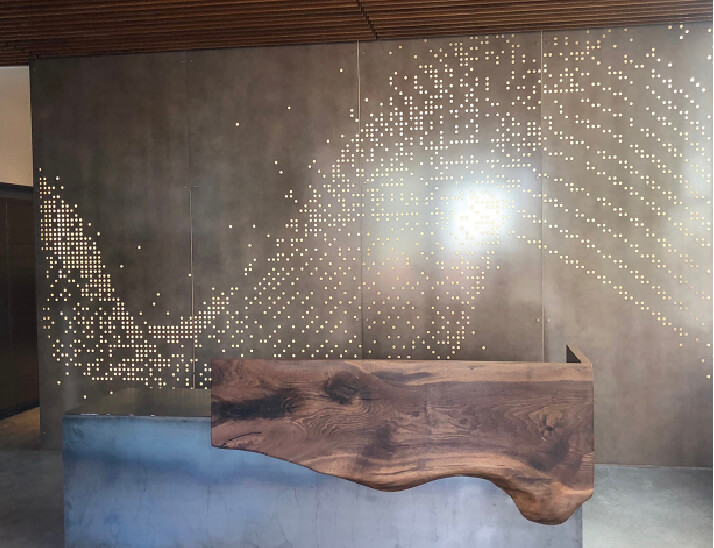
A new development complex in Dogpatch pays homage to an early technology pioneer who paved the way for Silicon Valley. The site – 815 Tennessee Street – used to be home to the Bowie Switch Company, which specialized in large-capacity electrical controls.
In engineering, a switch is a component that can “make” or “break” an electrical circuit, interrupting the current or diverting it from one conductor to another. The switch removes or restores the conducting path in a circuit when it’s operated. A large-capacity switch does this on a broader scale. Before Augustus Jessie Bowie Jr. invented them, no such large-capacity switches existed.
Bowie, Bay Area born and bred, founded his eponymous company in 1913 at 18th and Folsom streets. In 1926, the business moved to a newly built factory at 815 Tennessee Street. Bowie filed numerous patents for large-capacity electrical switches, including the 1,000-pound, 287 kilovolt disconnecting switch, instrumental to the spread of electrification on the West Coast during the 1910s and 1920s.

Prior to Bowie’s disconnecting switch, 2,300-volt electrical distribution systems were the standard, capable of conveying electricity about four miles before voltage drop rendered the remaining current useless. To disseminate electricity further distances, higher-voltage systems were needed that wouldn’t cause injuries, explosions, or destroy equipment. Bowie’s high-capacity switches did just that. They could safely regulate electricity flow from generation sites through lines that had the capacity to carry power over 250 miles to urban, rural, and newly developing suburban areas. The Bowie Switch Company directly supplied and implemented the large-capacity switches for the San Francisco metropolitan area, as well as the Hoover and Grand Coulee dams, among many other sites. During World War II, the company expanded to produce switches for the American war effort.
John Loomis, an architect, architectural historian, and professor of design at San Jose State University asserts these efforts laid the foundation for Silicon Valley.
“I know this is kind of schematic, but before Steve Jobs, there was Douglas Englebart. Before Englebart there was William Schockley. Before Schockley there was Lee De Forest. Before De Forest there was Augustus J. Bowie Jr. I can see no technology entrepreneur before Bowie,” he said. “So, he was the first technology entrepreneur in the Bay Area, an early seed that led to Silicon Valley, where computers are in a sense simply networks of binary circuits controlled by switches constantly clicking on and off.”
Not everyone agrees with Loomis. The City’s Historic Preservation Commission unanimously voted in 2015 not to add 815 Tennessee Street to the Landmark Designation Work Program, finding that the property didn’t have the significance level required under Planning Code Article 10 to be designated a municipal landmark. “Documentation does not support the subject property’s unique role in electricity or electrification of the United States, its role as the first new technology enterprise in the Bay Area, and its role as an early precursor to Silicon Valley,” the Commission report stated.
The property also didn’t appear to meet the Historic Preservation Commission’s priorities for recognition, which includes sites associated with an underrepresented ethnic/cultural association, property type or neighborhood, and modern design. “Department staff finds that the building is typical of the small industrial businesses in the area at this time period and does not appear to be individually significant,” the report also stated.
DM Development, which owns the Bowie Switch Company property, believes that its past merits mentioning. “Dogpatch is rich in history, which makes it distinct from newer neighborhoods in San Francisco, and we wanted our residents to understand and appreciate our building’s heritage,” said DM Development co-founder Mark MacDonald. “It was important to the neighborhood that we preserve the building’s legacy, and it allowed us the opportunity to offer our residents something very unique and special.”
The firm placed a plaque at 815 Tennessee Street that describes the building’s history and contains a link to a Wikipedia page DM Development created for Augustus Bowie Jr. and his electrical switch company. Bowie’s patent illustrations are included on 815 Tennessee’s website; there’s a custom, illuminated art wall in the lobby with a large graphic in the shape of an alternative current wave. At the end of each corridor in the structure the firm placed metal panels with large reproductions of Bowie’s patent images.
“We also preserved a large portion of the original brick factory, at the corner of 19th and Tennessee, that now serves as a public amenity for the neighborhood,” MacDonald said.
Swedish architect, August J. Nordin, designer of the historic landmark, Swedish American Hall, on upper Market Street, designed the brick-faced Bowie Switch Company in classic revival style according to the utilitarian tradition, part of which DM Development preserved.
“We should take satisfaction in the fact the real history has been preserved and disseminated, and not buried,” Loomis said. “We should be grateful for this. When you next walk by 815-825 Tennessee Street, remember this is where, back in the day, the ‘largest switches in the world’ were created for Hoover Dam. And ponder that given the binary code underlying all digital technology is based on a series of switches, the Bowie Switch Company laid important foundations for innovation in Silicon Valley.”




